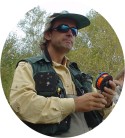
The take
This is the real emotion of this fishing mode. A trout can rise to your fly on any one of your casts. Whenever you achieve a perfect presentation you're a hundred percent sure it's going to tempt a trout. Independently of the number of times that the trout fails to materialize (most of them), you're-incomprehensibly-fully convinced that this superb cast is the one. Time and again, and you never get discouraged. And that, my friends, is the true magic of fishing the water with a dry fly. Sometimes you'll see the trout surge up from the depth; others, you won't see it until it takes your fly and sometimes you won't even see it until after you've hooked it (fast, churning waters).

Setting the hook
My advice for setting the hook is almost always the same: strike slowly but firmly. Raise the rod smoothly while pulling down and back on the line with your line hand. Don't think "strike." Think "set the hook." Just pull the line taut. There's usually plenty of time and, when you miss, it's almost always due to reacting too fast.
 As I've said on other occasions, mostly you don't
miss, nor does the trout. Either you jerk the fly out of the trout's mouth before it's closed or the fish hasn't actually taken it.
Remember that a fast rise to your fly is deceptive. The trout's body moves faster than its mouth, which must open, close and then
open again to spit out the strange object, independently of how fast the fish is moving in the process. Nymph fishermen often fail
to set the hook when they're using a dry fly. They tend to strike too fast (and too energetically), because that's how it needs to
be done when nymphing (as I understand it and as and I observe fellow anglers).
As I've said on other occasions, mostly you don't
miss, nor does the trout. Either you jerk the fly out of the trout's mouth before it's closed or the fish hasn't actually taken it.
Remember that a fast rise to your fly is deceptive. The trout's body moves faster than its mouth, which must open, close and then
open again to spit out the strange object, independently of how fast the fish is moving in the process. Nymph fishermen often fail
to set the hook when they're using a dry fly. They tend to strike too fast (and too energetically), because that's how it needs to
be done when nymphing (as I understand it and as and I observe fellow anglers).
Bristling with unknowns and surprises
Fishing the water with a dry fly is an agile, dynamic, exciting mode. It's full of exciting moments and numerous unknowns.
Here are some of the questions that keep popping into my mind as I practice this mode:
- What the devil was that trout doing there?
- I wonder how big it is? It sure is taking out a lot of line.
- If I hook one here, where in the world can I land it?
- How can I present a fly there without it dragging? Impossible.
- How did I manage to get my fly under those branches?
- And one of the most frequent: Where in the hell did that branch back there come from?
All these questions round out a tremendously fun and generally not-very-common way of fishing. Remember that this mode isn't incompatible with any other way of fishing. It's a good way to explore a new stretch or stream and to wake up some sleepy trout that otherwise might not give away their presence. If a trout rejects my fly, I can always stop and focus on it carefully. If I'm unsuccessful, next time at least I'll know a good possible catch lives there. There's a hatch and the trout start raising? Well, I stop and slow down all my rhythms, except my heartbeat, which accelerates; and I switch fishing modes. I pick a rising trout and focus on it. Fishing the water with a dry fly is fully compatible with and complements all the other modes. I encourage all the readers of this article to fish this way more often. I'm sure you'll discover a new and fascinating incentive in this increasingly difficult hobby of ours, fly fishing (difficult only because of the lack of trout). In this era of hooking fewer and fewer trout, our only option is to find a way to increase the intensity of the emotion with each one that we do hook.

Carlos Azpilicueta

